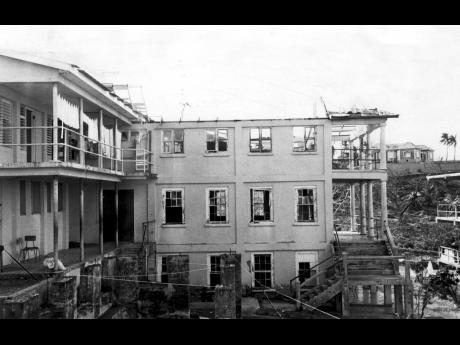Disaster insurance programme in the works for Jamaica
Jamaica has felt the brunt of many storms, some with deadly effect, but one of the most devastating and economically disruptive was Hurricane Gilbert.
So when insurers and policymakers came together to assess Jamaica's exposure to natural disasters, they evoked the near two-decade-old storm that tore apart roads and bridges, deconstructed homes and businesses, and claimed several lives.
Were Hurricane Gilbert to hit today, the cost to Jamaica would be around US$1.3 billion ($167 billion), said the Fiscal Policy report for the 2017-18 fiscal year. That estimate is more funds than the Government holds for its budgeted disaster response.
But of even greater concern is that given the financial gap, another storm of the magnitude of Hurricane Gilbert could result in a fall-out in economic activity that would threaten the gains made over recent years, according to the state document.
And it's not the greatest disaster that technocrats are expecting within a model for a 250-year storm event. Those projections rise to US$3.5 billion or 25 per cent of the country's national output, or GDP. An earthquake would likely result in US$2 billion of damage.
"This would be a significant setback to the macroeconomic stability of Jamaica," said the fiscal policy tabled by the Ministry of Finance with other Budget documents.
Jamaica is insured against natural disasters through the regional facility CCRIF - the Caribbean Catastrophe Risk Insurance Facility - but payout from that policy is limited, based on the coverage purchased. Contextually, the largest payout ever made by CCRIF was US$20 million to Haiti last year; and since the facility began operating in 2007, it's total payout to date to eight country members have amounted to US$35.57 million.
The Jamaican Government, general insurers and the World Bank are evaluating ways for Jamaica to reduce this risk and create a better recovery plan. It's being done through the Disaster Risk Financing Technical Assistance Programme (DRFTA), which the fiscal paper stated is in the process of quantifying the direct contingent liability.
The Ministry of Finance, meantime, plans in the "next few months" to create a financial protection strategy against disasters.
"Preliminary analysis suggests that existing instruments for disaster-related fiscal protection are not yet optimised to address Jamaica's disaster risk profile," stated the fiscal policy.
Last July, the Government received a US$30-million loan from the World Bank as part of the Disaster Vulnerability Reduction Project to run under a six-year disaster-mitigation programme.
Several efforts to speak with general insurers and the broader Insurance Association of Jamaica on their part in the programme were unsuccessful.
The National Disaster Fund is the main budgetary instrument for the GOJ to finance disaster recovery, but it is undercapitalised at US$2 million as of March 2015-16, according to the fiscal policy paper. The GOJ Contingencies Fund, established in the Constitution, was capitalised with US$825,000 in 2014, it added.
Jamaica pays US$6.3 million per annum in insurance premiums to CCRIF, but it's generally seen as inadequate to cover billions of dollars in damage, hence the rationale for DRFTA, which so far has held discussions with local insurance companies on the risk appetite for insuring public assets.
The issue is complicated by low insurance penetration in the private market. Insurers say the penetration for non-life insurance is just 2.2 per cent, and that the low coverage is due in part to 20 per cent of the population living below the poverty line; reinsurer risk due to hurricanes; and limited alternative risk-transfer mechanisms.
The DRFTA programme presents options for combinations of new, existing, and refurbished risk retention and risk-transfer instruments that could help the GOJ with disaster management without pressuring its finances.
Progress on this activity has led to discussions with the finance ministry about a financial protection strategy against disasters that is to be crafted in the next few months.
DRFTA has built a 'country disaster risk profile', and the results and methodology were discussed and validated with the Government, the Insurance Association of Jamaica, and the Financial Services Commission, which regulates the insurance market.
These results show that in Jamaica, the long-term, annualised average loss related to hurricanes is US$67.3m or 0.5 per cent of GDP, while for earthquakes it is US$36 million or 0.3 per cent of GDP.
"Hence, this means that, for example, if Hurricane Gilbert that devastated Jamaica in 1988 were to happen now, it would cause a loss of US$1.3 billion, amounting to 9.6 per cent of GDP," the fiscal paper noted.


